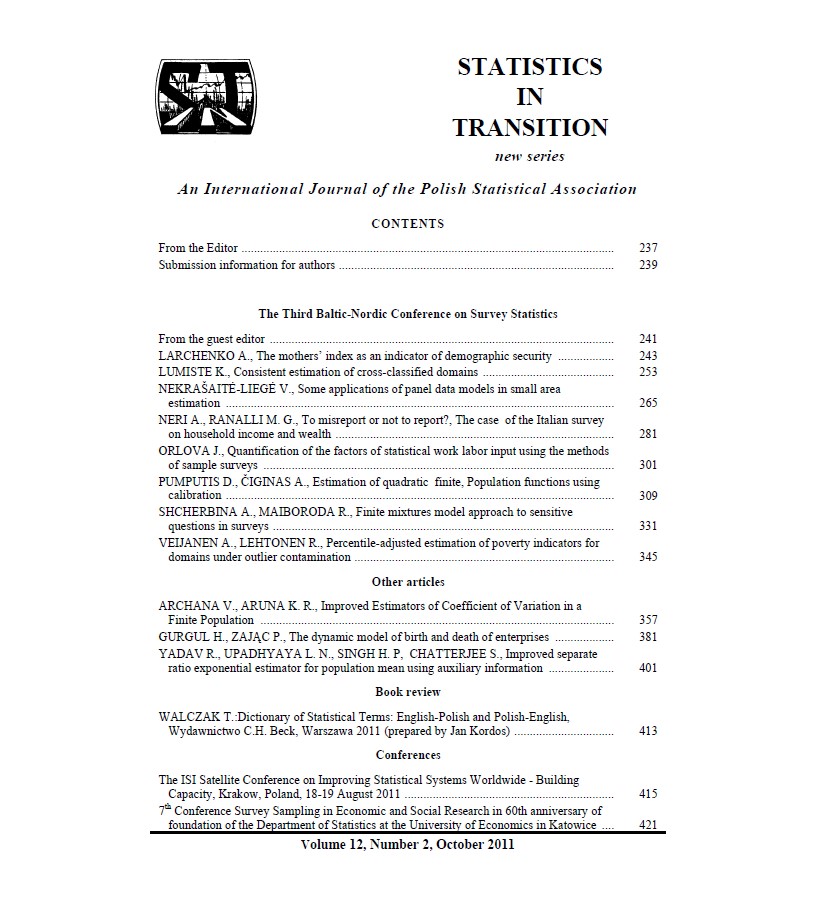ARTICLE
ABSTRACT
Domain estimation has become an important area in survey sampling, however a lot of problems associate with it. One out of many is the lack of consistency between different surveys. The results of one survey do not coincide with the results of another survey done earlier or simultaneously, although the same variable is under study.
We study two methods, AC-calibration (A – auxiliary, C – common) and repeated weighting (RW), for achieving consistency. A short overview of these two methods is given, and we develop formulas for a specified case, for the cross-classified domains.
We assume that there are two sources of information on the study variables (either surveys or registers). The problem is that one source has information on domains formed by certain categorical variable, not considered or not identified in the other source. Instead, this second source has information on domains formed by another categorical variable. We are however interested in domains cross-classified with these categorical variables. A survey is done regarding these new domains, but the domain estimates will probably be inconsistent with marginal information, from earlier surveys. We require that the new domain estimates be consistent with the marginals. To achieve this we apply AC-calibration or repeated weighting.
The formulas of AC-calibration and RW for the cross-classified domains are tested in a simulation study. Simulations were done on a population composed of real data from the Estonian Household Survey.
KEYWORDS
Consistent estimation; calibration; AC-calibration; repeated weighting
REFERENCES
Deming, W.E., Stephan, F.F., 1940. On a Least Squares Adjustment of a Sampled Frequency Table When the Expected marginal Totals are Known. The Annals of Mathematical Statistics, 11, pp.427-444.
Deville, J-C., Särndal, C.-E., 1992. Calibration Esitmators in Survey Sampling. Journal of the American Statistical Association, 87, pp.376-382.
Deville, J.-C., Särndal, C.-E., Sautory, O., 1993. Generalized Procedures in Survey Sampling. Journal of the American Statistical Association, 88, pp.1013-1020.
Elvers, E., Rosén, B., 1999. Quality Concept for Official Statistics. In: S. Kotz, C.B. Read, and D.L. Banks eds. Encyclopedia of Statistical Sciences, Update Volume 3. New York: Wiley, pp.621-629.
Estevao, V.M., Särndal, C.-E., 2000. A Functional Approach to Calibration. Journal of Official Statistics, 16, pp.379-399.
Estevao, V.M., Särndal, C.-E., 2004. Borrowing Strength Is Not the Best Technique Within a Wide Range of Design-Consistent Domain Estimators. Journal of Official Statistics, 20, pp.645-669.
Houbiers, M., 2004. Towards a Social Statistical Database and Unified Estimates at Statistics Netherlands. Journal of Official Statistics, 20, pp.55-75.
Knottnerus, P., 2003. Sample Survey Theory. Some Pythagorean Perspectives. New York: Springer
Knottnerus, P., van Duin, C., 2006. Variances in Repeated Weighting with an Application to the Dutch Labour Force Survey. Journal of Official Statistics, 22, pp.565-584.
Kott, P.S., 2006. Using calibration weighting to adjust for nonresponse and coverage errors. Survey Methodology, 32, pp.133-142.
Kroese, A.H., Renssen, R.H., 1999. Weighting and Imputation at Statistics Netherlands. Proceedings of IASS Satellite Conference on Small Area Estimation, Riga:Latvia, pp.109-120.
Platek, R., Särndal, C.-E., 2001. Can a Statistician Deliver?. Journal of Official Statistics, 17, pp.1-20.
Särndal, C.-E., 2007. The Calibration Approach in Survey Theory and Practice. Survey Methodology, 33, pp.99-119.
Särndal, C.-E., Traat, I., 2011. Domain Estimators Calibrated on Information from Another Survey. Acta et Commentationes Universitatis Tartuensis de Mathematica, vol. 15 (to appear).
